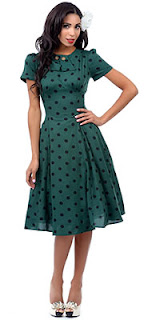Swing dancing was the latest and greatest social fad of the 1940's. While middle aged and above adults still enjoyed ballroom and ragtime dances like the foxtrot and tango, the young kids were breaking social norms and engaging in Swing Dancing. I always assumed that swing dancing in the 1940's required wearing special clothes and shoes. As it turns out clothing worn for swing dancing was the same clothing young women wore do any day or evening wear. The reason may have a lot to do with War rationing restrictions on new clothes and perhaps just because they were already comfortable enough.
Since swing dancing was mostly a dance for teenagers and college students they wore what was fashionable to them. They liked to wear knee length a-line skirts in solid colors or especially bright plaids. In the early 40’s the skirts didn’t have any pleats or extra fabric that would have made them “swing” with movement. In the later 40’s skirts had more pleating so there was a little bit more movement to them. However these were not the large skirted dresses of the 50’s with the multiple layers of petticoats. The only garments worn under these skirts were the usual girdle, panties, nylons and slips. Because of the narrowness of the skirt and the longer knee length women didn’t run much risk of twirling up skirts and exposing their under things during vigorous swing dancing.
Skirts were macthed with a basic blouse, with short puffy sleeves, in either a solid light color or fun wide stripes. Teenagers were also fond of cardigan style sweaters worn over their blouses or hung around their shoulders. Another popular sweater style was the “Sloppy Joe” an oversize knit sweater that looked baggy and might feature schools letters on the front.
As for dresses teens like simple cotton shirtwaist dresses in fun colors with small patterns. A shirtwaist dresses buttoned down the front ending at the waist or buttoned all the way down the dress. These were simple easy and casual. They were very comfortable to dance in too. The bodice had short sleeves (down to the elbow, or capped at the high shoulder) and a snug high waist. The dress collar could be v-neck with a pointed collar or have a adorable rounded peter pan collar made of the same fabric as the dress. Contrasting colors, such as white, also became popular after the "Kitty Foyle" style dress took the fashion world by storm. Other 1940's dress styles were worn too. Pretty much if you had it in your closet you could wear it to a swing dance.
Teens loved to wear oxfords and saddle shoes with bobby socks. They wore these swing dancing too. Unlike moderns hoes that have rubber "no slip" soles 1940's shoes were usually smooth leather which made them easy to dance in. For fancier occasions women would wear basic round toe pumps with low heels.
To learn about all the different types of dresses, skirts, blouses, shoes and accessories worn by women in the 1940’s you need to get a copy of the 1940’s Style Guide: The Complete Illustrated Guide to 1940’s Fashion. This ebook shows you not only what to wear but how to do your hair and makeup, what shoes are best for dancing, and where to buy everything you need for a 40’s swing outfit. If you don’t read this book first you will inevitably buy a dress from the wrong decade or spend countless hours searching online for a “swing dress” only to miss out on some of the best shopping sites that don’t show up in google searches. Save yourself time and money with this ebook. Guaranteed.



Wonderful! I always wear a circle skirt and plimsolls for Swing dancing, so now I don't feel too horrendously period inaccurate! :)
ReplyDelete